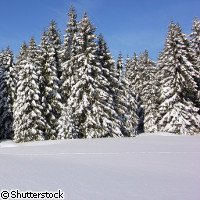Researchers study a brand new Christmas story
At this time of year millions of us are happily decorating our Christmas tree with tinsel, stars and baubles, but few may know that the traditional Christmas spruce or fir tree comes from a species that is millions of years old and has seven times more DNA than a human being! Now a team of Swedish researchers is to map the genome of the Norway spruce, a project that will be the largest effort so far to tackle the DNA of coniferous trees. The project, which will take four to five years, will be carried out by a consortium of researchers from the Umea Plant Science Center (UPSC), the Royal Institute of Technology (KTH), and the Karolinska Institute, all based in Sweden. Researchers from Canada, Italy and Belgium will also be involved. The project will be funded with a grant of SEK 75 million (EUR 7.2 million) from the Knut and Alice Wallenberg Foundation, a Swedish organisation that funds research. 'The fact that the Swedish spruce will be the first conifer to have its genome mapped is extremely important to both Swedish forestry research and the forestry industry,' said Professor Ove Nilsson of the UPSC, who will chair the project's steering group. 'A complete mapping of the genes of the spruce will revolutionise Swedish tree research and enable us to make more efficient use of wood raw material.' Conifers (cone-bearing, mostly evergreen trees which include the spruce and pine) are thought to be the world's oldest trees. There are over 600 species of conifer. Surviving geological disasters and meteorites, they pre-date the dinosaurs and still dominate many parts of the world today. Conifers have a highly complex DNA structure including 12 chromosomes. One cell from a spruce or pine tree has seven times as much DNA as a human cell. Scientists do not yet know why. 'The genetics of the spruce are truly exciting,' said project director Professor Pär Ingvarsson from the UPSC. 'Genetically, trees differ tremendously from each other, and while Swedish forest genetics has always been prominent, this constitutes a giant step forward in the work to achieve tree nursery material that is adapted to the very different conditions that prevail in our country, above all in the time of climate change we are facing.' Genomic mapping of the spruce will be invaluable to Sweden economically because the tree dominates the Swedish forestry industry and is its most important raw material. Professor Stefan Jansson from the UPSC said, 'It will provide us with the possibility of developing genetic tests for the various properties of trees such as the fuel value of the wood, or the trees' frost resistance and resistance to disease, just as the mapping of the human genome has made this possible in medicine.' The rapid developments in DNA sequencing technology over the last two years have allowed such an extensive genome mapping project to be initiated. 'Many other Swedish scientists will benefit from this project, so the eventual aggregate impact will be huge,' said Professor Jan Stenlid from the UPSC. 'For instance, we will have an entirely new capacity to understand and thereby combat two major scourges for Swedish forestry, root rot and the pine weevil.'
Countries
Belgium, Canada, Italy, Sweden

